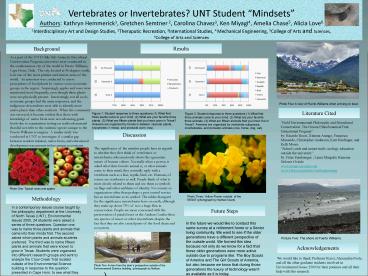Background PowerPoint PPT Presentation
1 / 1
Title: Background
1
Vertebrates or Invertebrates? UNT Student
Mindsets Authors Kathryn Hemmerick1, Gretchen
Semtner 2, Carolina Chavez3, Ken Miyagi4, Amelia
Chase5, Alicia Love6 1Interdisciplinary Art and
Design Studies, 2Theraputic Recreation,
3International Studies, 4 Mechanical Engineering,
5College of Arts and Sciences, 6College of Arts
and Sciences
Results
Background
As a part of the UNT-Chile Sub-Antarctic
Biocultural Conservation Program, interviews were
conducted in the southernmost city of the world
in Puerto Williams, Cape Horn, Chile. The city,
located at 56 degrees south, is in one of the
most pristine and remote areas of the world. An
interview was conducted to assess perceptions of
local plants by various socio-economic groups in
the region. Surprisingly, apples and roses were
mentioned most frequently, even though these
plants were not physically present.
Interestingly, not all socio-economic groups had
the same responses, and the indigenous
descendents were able to identify more native
plants than other residents. When the community
was surveyed, it became evident that those with
knowledge of native biota were not advancing
grade levels due to examination testing on
textbook material that did not refer to the
endemic species unique to the Puerto Williams
ecoregion. A similar study was conducted at UNT
to investigate if a similar gap between resident
mindset, native biota, and educational
development was present in less unique ecosystems.
. .
Photo Four A view of Puerto Williams when
arriving on boat.
Literature Cited
Figure 1 Student response to three questions (1)
What first three plants come to your mind, (2)
What are your favorite three plants, (3) What are
fifteen plants that you know grow in Texas?
Answers are organized by trends in dataset
vascular plants, bryophytes (1 moss), and
products (corn, hay).
Figure 2 Student response to three questions (1)
What first three animals come to your mind, (2)
What are your favorite three animals, (3) What
are fifteen animals that you know live in Texas?
Answers are organized by vertebrate subgroups,
invertebrates, and domestic animals (cow, horse,
dog, cat).
Field Environmental Philosophy and Biocultural
Conservation The Omora Ethnobotanical Park
Educational Program by Ricardo Rozzi, Ximena
Arango, Francisca Massardo, Christopher Anderson,
Kurt Heidinger, and Kelli Moses School yards and
nature trails ecology education outside the
university by Peter Feinksinger , Laura
Margutti, Ramona Dolores Oviedo
www.images.google.comwww.flickr.com/photos/natha
npenning
Discussion
The significance of the mindset people have in
regards to whether they first think of
vertebrates or invertebrates subconsciously shows
the egocentric nature of human culture. Normally
when a person is asked what their favorite animal
is, or what animals come to their mind, they
normally reply with a vertebrate such as a lion,
reptile, bird, etc. Humans, of course are
vertebrates as well. People think of what is most
closely related to them and use them as symbols
on flags and other emblems of identity. No
country or organization other than perhaps a pest
control service has an invertebrate as its
symbol. The udder disregard for the significance
invertebrates have on earth, although they make
up about 75 of it, is a huge flaw in
conservation. People are more concerned with the
preservation of panda bears or the Andean Condor
then any species of insect or other invertebrate
despite the fact that they are also crucial parts
of the food chain and ecosystem.
Photo One Typical roses and apples
Methodology
Photo Three Yellow Flower outside of the EESAT
(photograph by Nathan Clark).
In a contemporary issues course taught by the
philosophy department at the University of North
Texas (UNT), Environmental Issues 2500, 24
students were asked a series of three questions.
Question one was to name three plants and animals
that came into their minds first. The second
asked which plants and animals students
preferred. The third was to name fifteen plants
and animals that were known to grow in Texas.
Students were organized into different research
groups and sent to analyze the Crow Creek Trail
located outside of the Environmental Science
building in response to the question presented in
Cape Horn to see what they could learn about
plants and animals outside of the classroom.
Future Steps
In the future we would like to conduct this same
survey at a retirement home or a Senior living
community. We want to see if the older
generations have a different perspective of the
outside world. We formed this idea because not
only do we know for a fact that these older
generations were more active outside due to
programs like The Boy Scouts of America and The
Girl Scouts of America, but also because we know
that during those generations the luxury of
technology wasnt as available as it is today.
Picture Five The shore at Puerto Williams.
Acknowledgements
We would like to thank Professor Rozzi,
Alexandria Poole, and all the other graduate
students involved in Environmental Issues 2500
for their patience and all their help with this
research.
Photo Two A view from the deers perspective
outside of the Environmental Science building.
(photograph by Nathan Penning)

